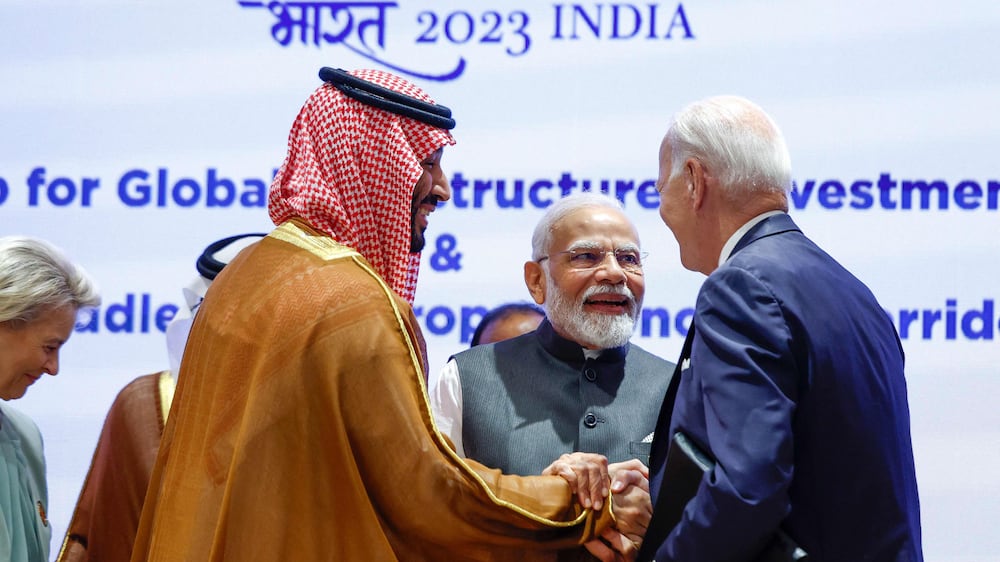A payment card initiative in the UAE based on India’s RuPay card, which was revealed this week, will become operational by the middle of next year, India’s Minister of Commerce and Industry has said.
The two countries entered into a strategic agreement to develop the Emirates’ domestic card programme, officials announced on Thursday.
Both countries have also agreed to allow the usage of the UAE-issued cards in India and the RuPay card in the Arab country, Piyush Goyal told The National.
“In a way, we'll make it fungible and it'll enable residents of UAE who come to India to use their card, they don't have to have a separate card."
RuPay is a global card payment network with wide acceptance at shops, ATMs and online platforms, with debit, credit and prepaid options.
More than 750 million RuPay cards are in circulation and they make up more than 60 per cent of the total cards issued in India.

The UAE's national domestic card programme will be developed by the UAE Central Bank's Al Etihad Payments company along with the National Payments Corporation of India's subsidiary NPCI International Payments.
The goal is to enable the growth of e-commerce and digital transactions in the Emirates, boost financial inclusion and support the country’s digitisation goals.
“The advantage with RuPay and its technology backbone is its very low-cost, so we'll bring down the cost of transacting between the two countries,” Mr Goyal said.
The Reserve Bank of India and the UAE Central Bank have also agreed to work together to use the India Stack, a set of digital infrastructure components that allows governments, businesses and individuals to conduct transactions electronically, he said.
India, the world’s fifth-largest economy, received close to $90 billion in remittance flows from around the world in 2022, with the UAE being the second-largest source of remittances to the country.
“We already have the rupee-dirham bridge by which we don't have to go via other currencies [and] which will [also] bring down the exchange costs of transactions between the two countries,” Mr Goyal said.
The UAE and India have been boosting ties following the signing of a comprehensive economic partnership agreement that came into force in May last year.
In the first 12 months of the pact, bilateral non-oil trade reached $50.5 billion, representing a growth of 5.8 per cent annually.
In July, the UAE and India signed agreements for establishing a framework to promote the use of local currencies for cross-border transactions and co-operation for interlinking their payment and messaging systems.
In August, the first crude oil transaction under the local currency settlement (LCS) system took place between Adnoc and the Indian Oil Corporation.
The transaction involved the sale of about a million barrels of crude oil, with Indian rupees and dirhams used.
“We need to educate businesspeople on both sides and bankers … [and] advise them and appraise them of the benefits of this new mode of transacting,” Mr Goyal said.
“There are certain questions and apprehensions … which we need to dispel, and we have agreed that we will be having missions from India to UAE and UAE to India, where we engage with bankers and businesspeople."
India, set to be the fastest-growing major economy this year, has been looking to internationalise the rupee to reduce dollar demand.
The rupee-dirham trade is “what is on the table” today and “we are focused on making this a big success”, Mr Goyal said.
Rail and shipping deal linking India, Middle East and Europe unveiled at G20

At the G20 summit last month in New Delhi, an India-Middle-East-Europe Economic Corridor was announced amid efforts to diversify supply sources from China.
The project will be made up of the east corridor connecting India to the Arabian Gulf and the northern section linking the Gulf and Europe.
“Teams from different countries are now working to flesh out all the details and I think over a period of time we'll hear more about what each country will be doing,” Mr Goyal said.
Collaborating on industry
The UAE and India on Thursday also signed a preliminary agreement to co-operate more closely in sustainable industrial development in line with Cepa.
The pact focuses on seven key areas – supply chain resilience, renewable energy and energy efficiency, health and life sciences, space systems, artificial intelligence, Industry 4.0 and advanced technology, as well as standardisation and metrology.
It is line with the objectives of the UAE's national industrial strategy, and the Make it in the Emirates initiative, "aimed at transforming the UAE into a global hub for advanced industry, especially industries of the future", said Dr Sultan Al Jaber, Minister of Industry and Advanced Technology.
“The [pact] encompasses various aspects of co-operation aimed at promoting industrial investments in priority sectors for the national economies of both countries, including advanced industries, energy transition solutions, health care and space," Dr Al Jaber, who is also Cop28 President-designate, said.
"It also aims to develop innovative and technological solutions that support sustainability and climate neutrality efforts.
"By working closely within these strategic sectors, the UAE and India can accelerate sustainable growth and diversify their economies, promoting industries that are more competitive, efficient and sustainable.”

To build supply chain resilience, the UAE and India will collaborate to identify opportunities in raw materials supply.
In the energy space, the two countries will collaborate in advancing storage technology, smart grid and the Internet of Things, as well as research and development in renewable energy and energy efficiency.
The countries will also co-operate in using AI in the space sector, energy, health care and supply chains. Both countries will work together to advance capabilities in machine learning and data analytics across priority sectors.
“This [pact] opens new doors to develop co-operation efforts and build an institutional framework in the fields of emerging technologies," Mr Goyal said.






